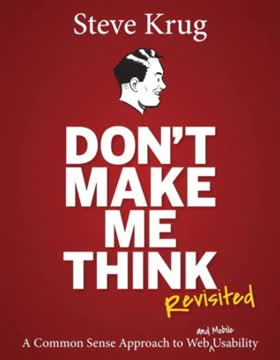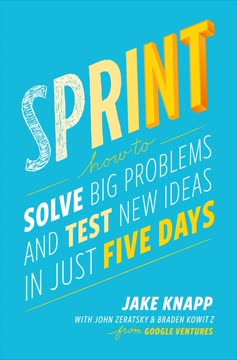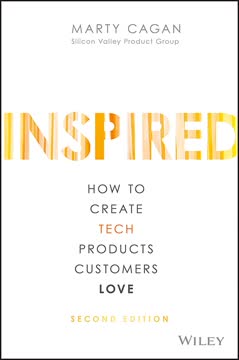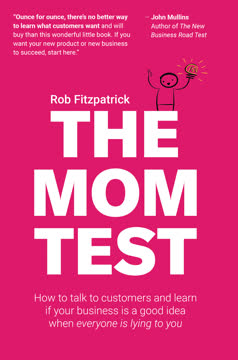Key Takeaways
1. Ask good questions to get real insights, not just compliments
The Mom Test: Talk about their life instead of your idea, ask about specifics in the past instead of generics or opinions about the future, and talk less and listen more.
Avoid biasing questions. When talking to potential customers, focus on their lives, problems, and past behaviors rather than your idea. This approach prevents people from giving you false positives or trying to protect your feelings. Instead of asking "Would you buy this?" ask about their current solutions, frustrations, and decision-making processes.
Use specific examples. Anchor conversations in concrete past experiences rather than hypothetical futures. For instance, ask "When was the last time you encountered this problem?" or "Walk me through how you currently handle this situation." This provides more reliable data about their actual needs and behaviors.
Good questions:
- "How are you dealing with X now?"
- "Talk me through the last time that happened."
- "What else have you tried?"
Bad questions: - "Do you think it's a good idea?"
- "Would you buy a product which did X?"
- "How much would you pay for X?"
2. Avoid bad data: compliments, fluff, and ideas
Compliments are the fool's gold of customer learning: shiny, distracting, and entirely worthless.
Recognize and deflect compliments. Compliments feel good but provide no real data. When someone says they like your idea, it doesn't mean they'll actually use or pay for it. Instead of accepting compliments, redirect the conversation back to learning about their problems and behaviors.
Beware of fluff and hypotheticals. Generic claims, future-tense promises, and hypothetical maybes are unreliable. People are overly optimistic about what they might do in the future. Focus on what they're actually doing now to solve their problems.
Types of bad data to avoid:
- Compliments: "That's cool, I love it!"
- Fluff: "I would definitely buy that."
- Ideas: Feature requests without understanding the underlying problem
3. Focus on important questions that could make or break your business
Every time you talk to someone, you should be asking a question which has the potential to completely destroy your currently imagined business.
Identify critical questions. Before each conversation, determine the 3 most important things you need to learn. These should be questions that could potentially invalidate your business idea or dramatically change your approach.
Face the scary questions. Don't shy away from asking about potential deal-breakers, such as budget constraints, decision-making processes, or competing solutions. It's better to uncover these issues early rather than after you've invested significant time and resources.
Examples of important questions:
- "Where does the budget for this come from?"
- "Who else would need to be involved in the decision?"
- "What are the implications if this problem isn't solved?"
4. Keep conversations casual to get genuine responses
Learning about a customer and their problems works better as a quick and casual chat than a long, formal meeting.
Avoid formal meetings when possible. Casual conversations often yield more genuine and valuable insights. People are more likely to open up and share their real thoughts in a relaxed setting.
Seize everyday opportunities. Look for chances to have relevant conversations in your daily life, such as at industry events, conferences, or even social gatherings. This approach allows you to gather insights without the pressure of a formal meeting.
Tips for keeping it casual:
- Start with general small talk before diving into your questions
- Ask about their work or interests related to your product area
- Use natural segues to introduce your key questions
- Keep the conversation flowing like a normal chat, not an interview
5. Seek commitment and advancement to validate interest
If you don't know what happens next after a product or sales meeting, the meeting was pointless.
Push for concrete next steps. At the end of each conversation, aim for a clear commitment or advancement. This could be a follow-up meeting, an introduction to a decision-maker, or even a pre-order.
Recognize real interest. True validation comes from people giving up something valuable, such as time, money, or reputation. Mere compliments or vague promises of future interest are not reliable indicators.
Types of commitment to look for:
- Time: Agreeing to a product demo or trial
- Reputation: Introducing you to their team or boss
- Money: Pre-orders, letters of intent, or deposits
6. Find the right customers to talk to
If you aren't finding consistent problems and goals, you don't yet have a specific enough customer segment.
Define your ideal customer. Be as specific as possible about who your product is for. This helps you focus your conversations and get more consistent, actionable feedback.
Use customer slicing. Start with a broad group and keep narrowing it down until you have a specific, reachable segment. Consider factors like demographics, motivations, and current behaviors.
Questions for customer slicing:
- Who within this group would want it most?
- Why do they want it?
- What are they already doing to solve this problem?
- Where can we find these people?
7. Segment your market to avoid drowning in options
When you have a fuzzy sense of who you're serving, you end up talking to a lot of different types of people, which leads to confusing signals.
Start specific, then expand. It's easier to serve a narrow market well and expand later than to try serving everyone from the beginning. This focused approach allows you to create a product that truly resonates with a specific group.
Look for consistent feedback. If you're getting wildly different responses from your conversations, it's likely your customer segment is too broad. Keep narrowing until you find a group with consistent problems and goals.
Benefits of proper segmentation:
- Clearer marketing messages
- More focused product development
- Easier to find and reach potential customers
- More consistent and actionable feedback
8. Prepare, review, and take good notes for effective customer conversations
If you don't know what you're trying to learn, you shouldn't bother having the conversation.
Prepare before each conversation. Know your current top 3 questions and any specific hypotheses you want to test. Do basic research on the person or company you're meeting to avoid wasting time on obvious questions.
Take detailed, structured notes. Use a consistent system to capture key information, such as pain points, goals, and specific quotes. This makes it easier to review and share insights with your team later.
Review and update regularly. After each conversation, review your notes with your team. Update your understanding of customer needs and adjust your top questions as needed.
Key elements to include in your notes:
- Exact quotes (use quotation marks)
- Emotional reactions
- Pain points and goals
- Current solutions and workarounds
- Specific names or companies mentioned
- Follow-up tasks or commitments
9. Involve your whole team in the learning process
Owning the customer conversations creates a de-facto dictator with "The customer said so" as the ultimate trump card.
Avoid learning bottlenecks. Don't let customer insights get stuck with one person. Involve the whole founding team, including technical members, in customer conversations and the learning process.
Share insights promptly and faithfully. Use your notes and exact quotes to disseminate learnings to your team as quickly as possible. This keeps everyone aligned and leads to better decision-making.
Ways to involve your team:
- Bring different team members to customer meetings
- Hold regular review sessions to discuss insights
- Share detailed notes and key takeaways after each conversation
- Encourage team members to ask questions and challenge assumptions
Last updated:
FAQ
What's "The Mom Test" about?
- Purpose of the book: "The Mom Test" by Rob Fitzpatrick is about how to have effective conversations with customers to validate business ideas without getting misleading feedback.
- Core concept: It introduces a method to ask questions that even your mom can't lie about, focusing on gathering truthful insights rather than compliments.
- Avoiding bias: The book emphasizes avoiding biased questions that lead to false positives, which can mislead entrepreneurs into thinking their idea is validated.
- Practical guide: It provides practical advice and tools from various methodologies like Customer Development and Lean Startup to improve customer conversations.
Why should I read "The Mom Test"?
- Improve customer conversations: It helps entrepreneurs learn how to talk to customers effectively to validate their business ideas.
- Avoid common pitfalls: The book addresses common mistakes in customer conversations that lead to misleading data.
- Practical advice: Offers actionable steps and real-world examples to improve the quality of feedback from customer interactions.
- Broad applicability: Useful for entrepreneurs, salespeople, mentors, and investors who want to understand customer needs better.
What are the key takeaways of "The Mom Test"?
- Ask about their life: Focus on the customer's life and past experiences rather than your idea.
- Avoid hypothetical questions: Steer clear of questions about the future or opinions, as they often lead to false positives.
- Seek commitment: Look for signs of commitment from customers, such as time, reputation, or money, to validate interest.
- Iterative learning: Continuously refine your questions and approach based on the feedback and insights gathered.
How does "The Mom Test" suggest avoiding bad data?
- Deflect compliments: Compliments are often misleading and should be deflected to focus on gathering facts.
- Anchor fluff: Avoid generic claims and future promises by anchoring questions in specific past behaviors.
- Dig beneath ideas: Understand the motivations behind feature requests or ideas rather than taking them at face value.
- Seek specifics: Always aim for concrete, specific examples from the customer's past experiences.
What is the "Mom Test" method?
- Life over idea: Talk about the customer's life instead of your idea to avoid bias.
- Specifics over generics: Ask about specific past events rather than hypothetical future scenarios.
- Listen more: Focus on listening rather than talking to gather genuine insights.
- Non-biasing questions: Craft questions that don't lead the customer to give you the answer you want to hear.
How can I apply "The Mom Test" in customer conversations?
- Prepare questions: Before conversations, prepare questions that focus on the customer's past experiences and problems.
- Keep it casual: Approach conversations informally to avoid setting expectations and biases.
- Seek advancement: Look for signs of commitment or advancement in the customer's interest.
- Review and iterate: After conversations, review notes with your team and refine your approach based on what you learn.
What are some examples of good and bad questions according to "The Mom Test"?
- Bad question: "Do you think it's a good idea?" This invites opinions and compliments rather than facts.
- Good question: "Talk me through the last time that happened." This asks for specific past experiences.
- Bad question: "Would you buy a product which did X?" This is hypothetical and often leads to false positives.
- Good question: "How are you dealing with it now?" This seeks to understand current solutions and pain points.
What are the signs of a successful meeting in "The Mom Test"?
- Facts gathered: You leave with concrete, specific facts about the customer's life and problems.
- Commitment shown: The customer shows commitment by giving up something of value, like time or money.
- Advancement achieved: The meeting ends with clear next steps or advancement in the sales process.
- Avoidance of fluff: The conversation avoids generic compliments and focuses on actionable insights.
How does "The Mom Test" suggest handling compliments and fluff?
- Deflect compliments: Politely deflect compliments to refocus the conversation on gathering useful data.
- Anchor generic claims: Ask for specific examples to anchor generic claims in reality.
- Challenge future promises: Question future promises by asking about past behaviors and current solutions.
- Focus on facts: Always steer the conversation back to concrete facts and past experiences.
What is the importance of customer segmentation in "The Mom Test"?
- Avoid drowning: Proper segmentation helps avoid being overwhelmed by too many options and mixed signals.
- Serve specific needs: Focus on a specific customer segment to tailor your product and marketing effectively.
- Consistent feedback: A well-defined segment provides consistent feedback, making it easier to validate ideas.
- Findable segments: Ensure your customer segments are specific enough to be easily found and engaged with.
How does "The Mom Test" recommend preparing for customer conversations?
- Identify big questions: Decide on the three most important questions you need answers to before the meeting.
- Research beforehand: Conduct desk research to avoid asking obvious questions and focus on deeper insights.
- Team involvement: Involve your team in preparation to ensure all perspectives are considered.
- Plan for commitment: Know what kind of commitment or advancement you want to achieve from the meeting.
What are the best quotes from "The Mom Test" and what do they mean?
- "Opinions are worthless." This highlights the importance of focusing on facts rather than opinions in customer conversations.
- "Talk about their life instead of your idea." Emphasizes the need to avoid bias by focusing on the customer's experiences.
- "The more they’re giving up, the more seriously you can take their kind words." Suggests that real commitment is shown through what customers are willing to sacrifice.
- "You aren’t allowed to tell them what their problem is, and in return, they aren’t allowed to tell you what to build." Stresses the division of responsibility between understanding the problem and creating the solution.
Review Summary
The Mom Test receives high praise for its practical advice on customer conversations for entrepreneurs. Readers appreciate its concise, example-filled approach to avoiding common pitfalls in customer interviews. The book emphasizes focusing on customers' lives and problems rather than pitching ideas. Many find it valuable for product development, startups, and general communication skills. Some criticize the simplistic premise and potentially reinforcing stereotypes. Overall, it's widely recommended as an essential read for anyone in product development or entrepreneurship, offering actionable insights for effective customer interactions.
Similar Books










Download PDF
Download EPUB
.epub digital book format is ideal for reading ebooks on phones, tablets, and e-readers.





